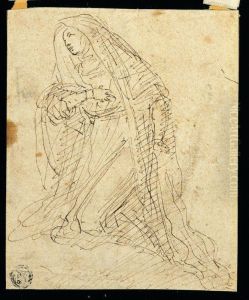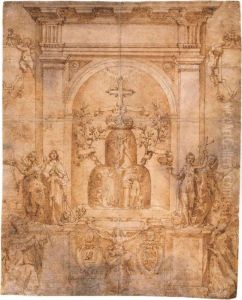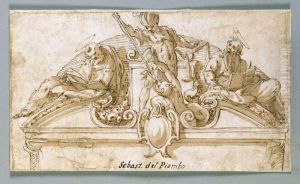Francesco Curia Paintings
Francesco Curia was an Italian painter, active during the late Renaissance period in the region of Naples. Although not as widely known as some of his contemporaries, Curia made notable contributions to the development of Neapolitan painting. Born in 1538 in the Kingdom of Naples, which was under Spanish rule at the time, Curia's artistic career was largely influenced by the prevailing styles and artistic movements of Italy and Spain.
Curia was a pupil of the painter Polidoro da Caravaggio, not to be confused with the more famous Michelangelo Merisi da Caravaggio. Under Polidoro, Curia learned the fundamentals of Renaissance art, characterized by its emphasis on classical forms, perspective, and human anatomy. His style evolved to reflect the Mannerist tendencies of the period, characterized by elongated figures and exaggerated poses, which were a reaction against the harmonious and naturalistic ideals of the High Renaissance.
Throughout his career, Curia worked on various religious commissions, which was typical for artists of his time. Churches and religious confraternities were the primary patrons of the arts, and much of Curia's work consisted of altarpieces, frescoes, and other ecclesiastical decorations. His paintings often featured scenes from the life of Christ, the Virgin Mary, and the saints. Curia's work was distinguished by its vibrant color palette and a certain dramatic intensity, which reflected the evolving tastes of the late 16th and early 17th centuries.
Despite his contributions, Francesco Curia remains something of an obscure figure in art history. This is partly because many of his works have been lost or damaged over time, and partly because he was overshadowed by other artists of the Baroque period, which followed closely on the heels of the Renaissance. However, his remaining works still offer valuable insights into the artistic environment of Naples during a period of significant transition and the interchange of ideas between the Italian and Spanish artistic traditions.
Francesco Curia died in 1610 in Naples. While his fame may not have endured as robustly as some of his peers, his works are appreciated by art historians for their embodiment of the Mannerist style and their role in the development of Neapolitan art. His legacy continues to be studied by those interested in the nuances of regional Italian art and the lesser-known artists who contributed to the rich tapestry of Renaissance art.



